Key takeaways:
- Effective collaboration between Africa and Europe hinges on building personal rapport and trust through open communication and shared experiences.
- Active listening and adaptability in communication styles are crucial for fostering an environment where diverse ideas can thrive.
- Recognizing and appreciating the contributions of each collaborator strengthens relationships and enhances project outcomes.
- Maintaining relationships over time through regular check-ins and small gestures reinforces trust and promotes long-term collaboration.

Understanding Africa-Europe collaboration
Understanding Africa-Europe collaboration requires an appreciation of the diverse cultural, historical, and scientific landscapes that both regions bring to the table. From my experience, engaging with this collaboration often unveils surprising synergies, such as the rich biodiversity in Africa that complements Europe’s advanced research techniques. Have you ever noticed how the blend of African traditional knowledge and European scientific rigor can lead to innovative solutions for global challenges?
In my discussions with collaborators, I’ve often sensed a genuine excitement about the potential for mutual benefit. For instance, during a project focused on climate change, I found that African partners offered invaluable local insights that deeply enriched the European perspective. This exchange isn’t just about science; it’s about forging relationships that respect and celebrate our differences while working towards common goals.
I remember sitting in a conference where a representative from Africa shared a story about local communities adapting to climate shifts. It struck me how essential it is to listen and learn from one another. Isn’t it fascinating how the stories and experiences we share often build stronger bridges than statistics alone ever could? By fostering this understanding, we can create a foundation for collaboration that thrives on empathy and shared purpose.
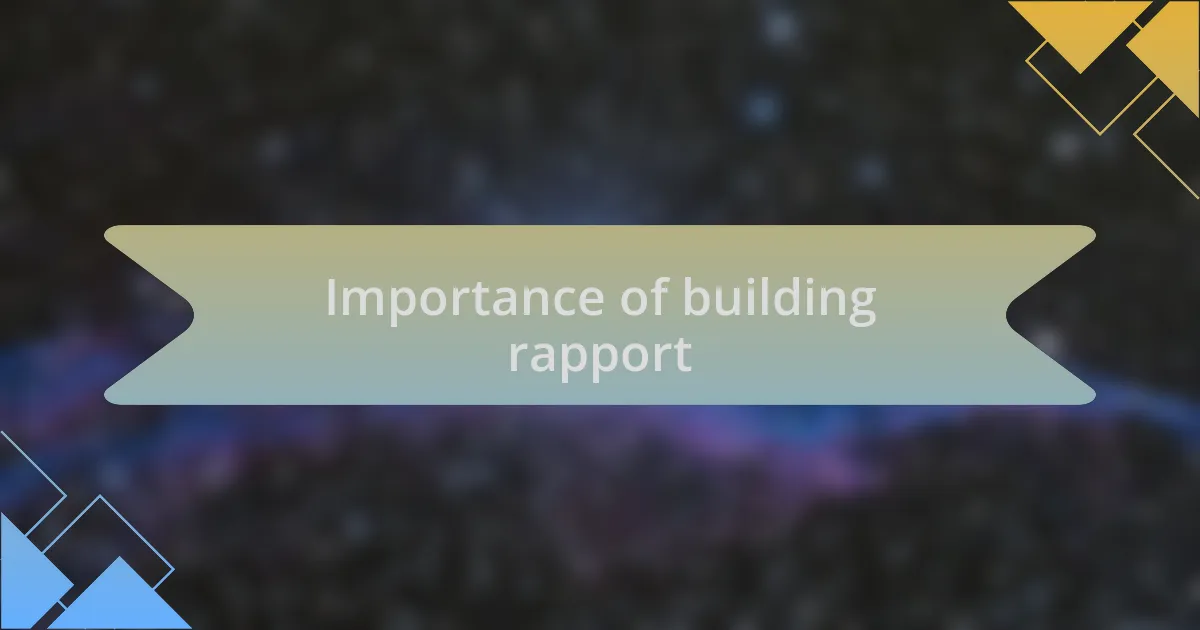
Importance of building rapport
Building rapport is crucial in any collaborative effort, especially in the context of Africa-Europe science partnerships. I recall a moment during a joint workshop where a simple icebreaker led to laughter and shared stories, transforming our group from strangers into a cohesive unit. It made me realize that when we establish personal connections, we set the stage for open communication and trust.
The benefits of building rapport extend beyond initial interactions. For instance, I once worked with a team that faced significant challenges due to cultural misunderstandings. However, after creating a safe space for dialogue, we were able to express concerns and brainstorm solutions together. This deepened our trust, ultimately leading to more innovative outcomes than I ever expected.
In my experience, when collaborators feel comfortable with one another, they’re more likely to share unique ideas and perspectives, which can significantly enhance project outcomes. Have you ever noticed how team dynamics shift when individuals engage on a personal level? It’s remarkable how that sense of connection fosters not just collaboration but genuine enthusiasm for the work we do together.

Key strategies for effective collaboration
Effective collaboration hinges on the establishment of clear communication channels. I once participated in a transcontinental research initiative where we used a shared online platform for updates and feedback. This transparency not only kept everyone in the loop but also fostered a sense of collective ownership over the project. Isn’t it fascinating how a few simple tools can streamline our efforts and bring us closer together?
Another key strategy involves recognizing and valuing each collaborator’s unique contributions. I remember a project where one team member, who specialized in local practices, shared insights that fundamentally shaped our approach. Acknowledging their expertise not only boosted their confidence but also strengthened our entire team’s synergy. Have you ever felt empowered when your ideas were genuinely valued? I believe that creating space for everyone to shine is essential for a thriving collaborative environment.
Building shared goals is equally important in aligning everyone’s efforts. During a collaborative workshop, we dedicated time to discuss our objectives collectively, ensuring that each participant felt invested in the project’s direction. This alignment not only minimized confusion but also ignited a shared passion for our mission. Isn’t it energizing when the whole team is on the same page, striving toward a common goal? I’ve found that it turns the entire collaborative process into a rewarding journey.
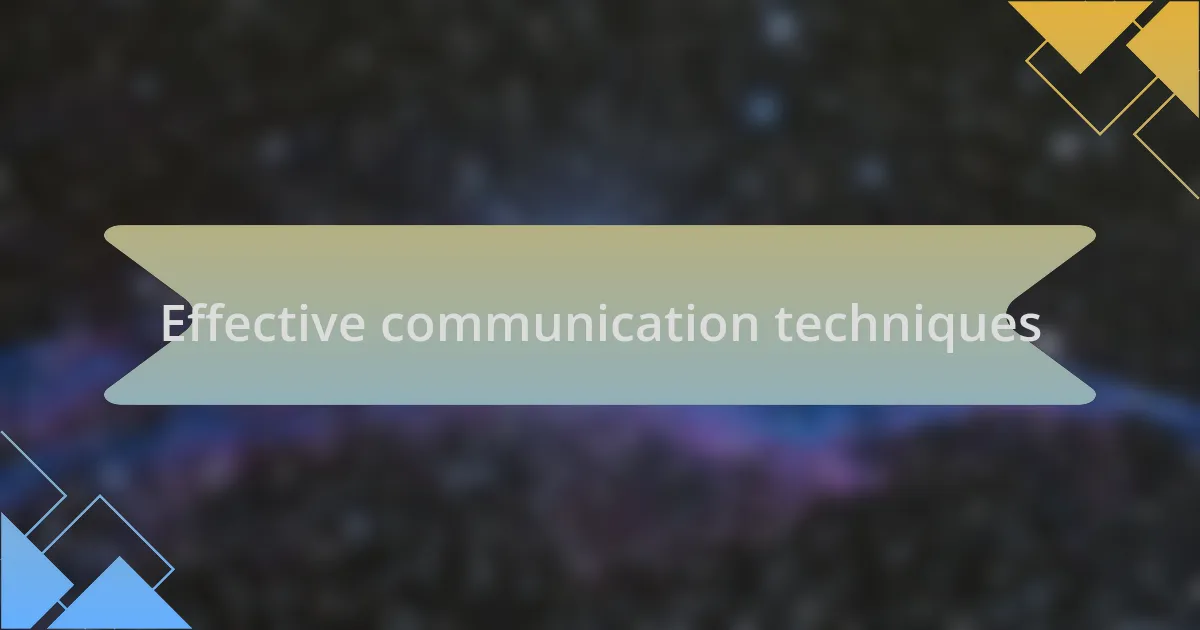
Effective communication techniques
When it comes to effective communication, active listening is vital. I recall a time during a project where tension arose due to misinterpretations. By taking the time to really hear my collaborators’ concerns, I discovered underlying issues that needed addressing. This experience taught me that when we genuinely listen, we not only clarify misunderstandings, but we also build trust. Have you noticed how powerful it feels when someone fully engages with what you say?
Another technique that has proven beneficial is adjusting my communication style to fit my audience. I once worked with a group of researchers from diverse backgrounds, and I realized that using technical jargon alienated some team members. By simplifying my language and incorporating visual aids, I made complex ideas more accessible. This approach not only facilitated clearer discussions but also encouraged everyone to contribute. Don’t you think that adaptability in communication helps in connecting with people on a deeper level?
Finally, fostering an atmosphere of open feedback can transform the communication dynamic. I learned this during a collaborative project where I encouraged my peers to share not just their thoughts on our progress but also on my contributions. The candid feedback I received was invaluable, revealing blind spots I hadn’t considered and ultimately strengthening our collaboration. Isn’t it empowering to create a space where everyone feels comfortable to voice their thoughts? Embracing this culture of feedback can significantly enhance our collective outcomes.
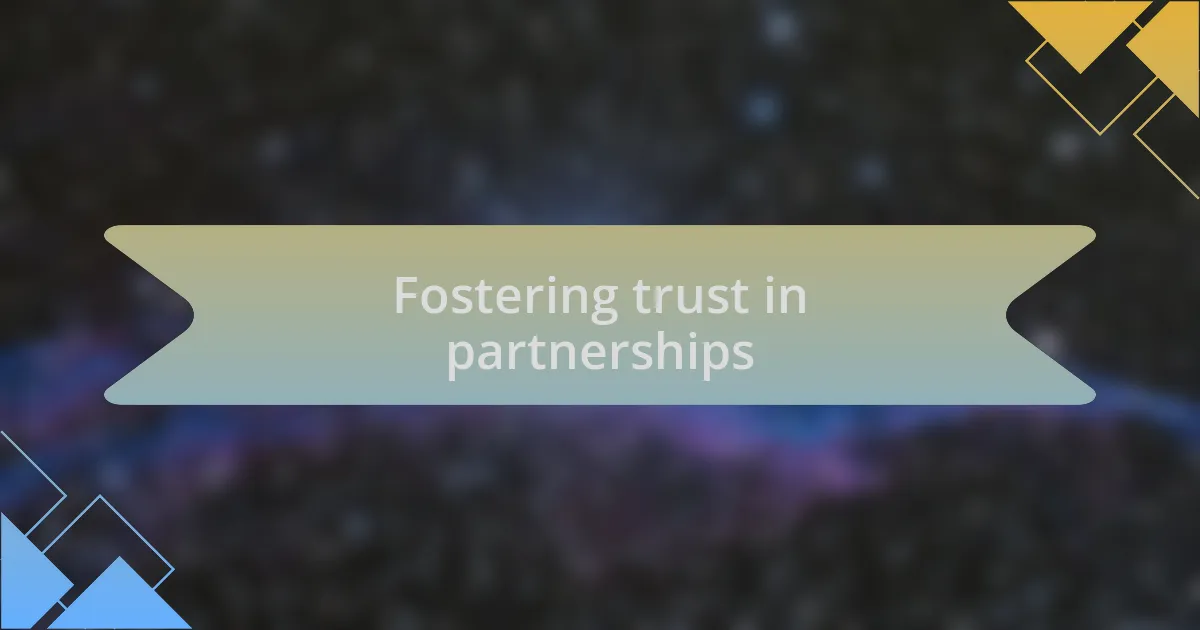
Fostering trust in partnerships
Building trust in partnerships is truly foundational for any collaborative effort. I remember a joint project where I was initially hesitant to share my ideas, fearing they might not be well-received. However, I soon realized that vulnerability often paves the way for deeper connections. When I opened up about my thoughts, I was met with encouragement, which not only boosted my confidence but also strengthened the bonds within the team. Have you ever felt that sense of relief and support when you let your guard down?
One essential aspect I focus on is reliability. There was a time when I promised to deliver my part of a project ahead of schedule. By doing so, I demonstrated my commitment not only to my work but also to my collaborators’ success. Meeting deadlines and following through on commitments not only builds trust but also sets a positive precedent. Don’t you think showing consistency through our actions can significantly enhance the trust dynamic?
Equally important is acknowledging and appreciating the contributions of others. I vividly recall the moment a colleague shared a brilliant idea during a project, and I made it a point to highlight their effectiveness. That simple act of recognition didn’t just make them feel valued; it created a culture of mutual respect and trust within our team. When was the last time you acknowledged someone’s input? It’s remarkable how much trust can flourish when everyone feels appreciated.
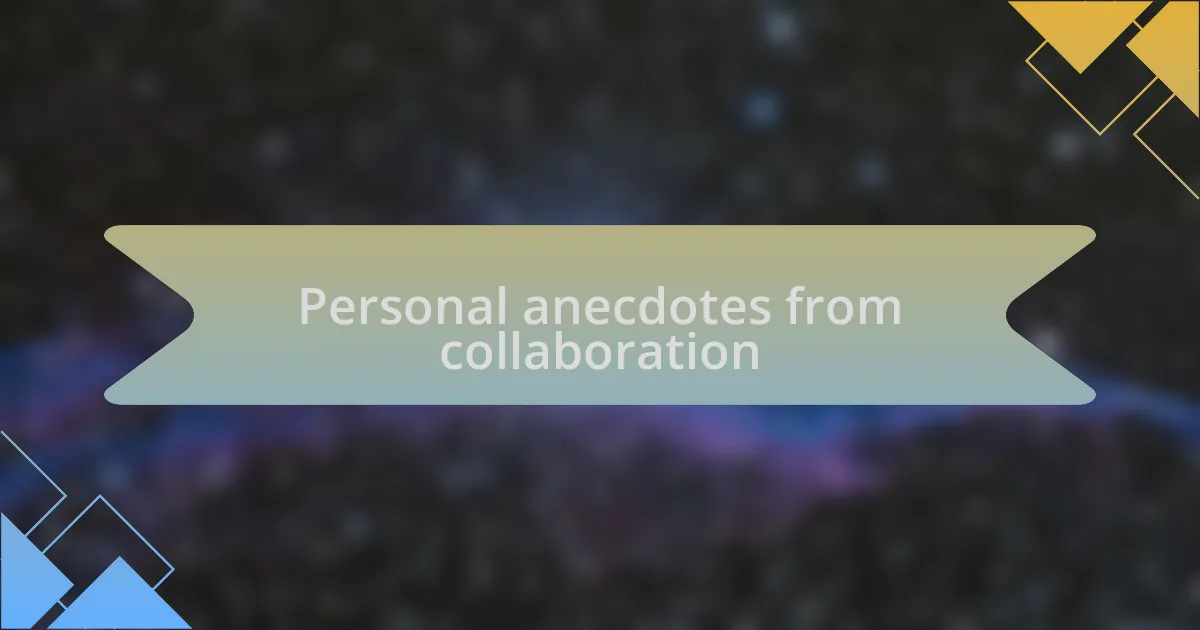
Personal anecdotes from collaboration
In one of my collaborations with researchers from Europe, I had the opportunity to participate in a field study in Africa. On the first day, we gathered to discuss our initial findings. I felt an array of emotions—anxiety mingled with excitement—as I shared my observations. To my surprise, my European colleagues responded with genuine curiosity and interest, sparking a meaningful dialogue that helped deepen our understanding. Have you ever felt your perspective truly valued in such a way? That experience taught me how crucial it is to create an environment where every voice is heard.
Another memorable collaboration unfolded when I was part of a workshop aimed at developing joint research proposals. We were a diverse group, each bringing unique insights shaped by our backgrounds. I realized that pushing past my initial reservations about sharing unconventional ideas often led to innovative outcomes. During those sessions, when I ventured outside of my comfort zone, it felt like a mosaic of ideas came to life. How often do we let fear limit our contributions in collaborative settings? My willingness to embrace vulnerability not only enriched the conversation but also created stronger connections among us.
Once, after a challenging project, I organized a small celebration for our team to acknowledge the hard work and effort put in by everyone involved. I recall feeling a wave of joy as we shared laughs and stories over food. It became clear that those moments of camaraderie helped solidify our rapport. While we had faced obstacles together, it was the shared recognition of our struggles and triumphs that drew us closer. Have you considered how simple gestures, like celebrating successes, can amplify trust within a team? These personal experiences remind me that genuine relationships are built through both struggles and shared victories.
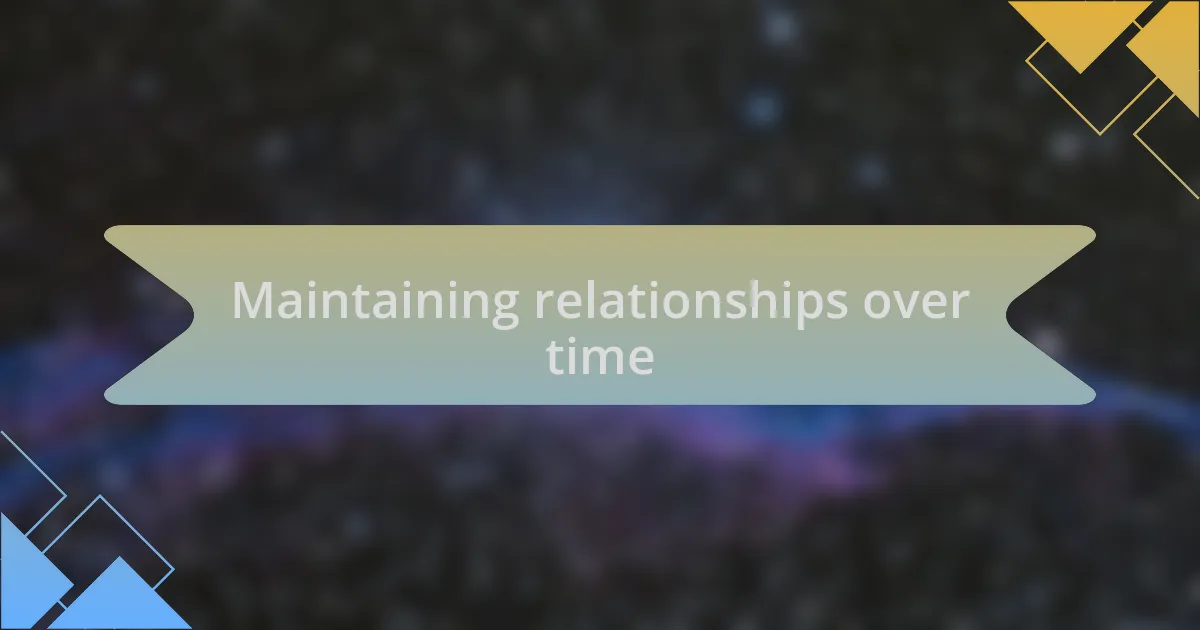
Maintaining relationships over time
Maintaining relationships over time can be a delicate dance, one I’ve grown to appreciate in collaborative settings. I remember a project where regular check-ins became our lifebuoy. These virtual coffee chats started as casual catch-ups, but soon, sharing our daily challenges fostered a deeper bond. Have you ever noticed how a simple “How are you?” can pave the way for more significant discussions?
In another instance, I made it a point to send occasional updates and resources that might benefit my collaborators. This practice wasn’t just about sharing information; it was a way to show I was genuinely invested in their work. When I received a heartfelt “thank you” after sharing a relevant article, I realized these small gestures can weave a tapestry of trust and support. How often do we take the time to nurture relationships beyond deadlines and deliverables?
One of the most rewarding aspects of maintaining long-term relationships is the joy of witnessing colleagues grow. I distinctly remember celebrating a peer’s promotion after years of collaboration. It felt like a shared victory, as if I had played a small part in their journey. In those moments, I often wonder: how can we continue to uplift each other in our respective paths? Through consistent encouragement and recognition of each other’s achievements, we keep the flame of collaboration alive, transforming professional relationships into lasting friendships.